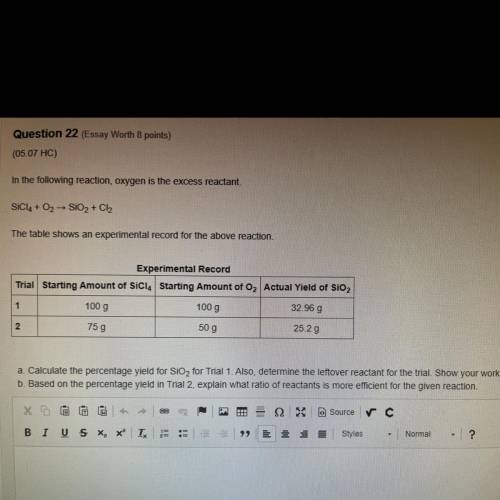In the following reaction, oxygen is the excess reactant.
SiCl4 + O2SiO2 + Cl2
The table show...

In the following reaction, oxygen is the excess reactant.
SiCl4 + O2SiO2 + Cl2
The table shows an experimental record for the above reaction.
a. Calculate the percentage yield for SiO2 for Trial 1. Also, determine the leftover reactant for the trial. Show your work.
b. Based on the percentage yield in Trial 2, explain what ratio of reactants is more efficient for the given reaction.


Answers: 3


Another question on Chemistry

Chemistry, 21.06.2019 17:00
In the analysis of hair and fiber samples, which does a compound comparison microscope allow for that a conventional compound microscope does not? a. simultaneous observation b. polarization c. fluorescence d. higher magnification
Answers: 2

Chemistry, 21.06.2019 20:50
Choose all that apply. when creating a graph, you should: determine the x- and y- variables label the scale on the x- and y- axes plot the data points draw a line of best fit to represent the data trend
Answers: 1

Chemistry, 22.06.2019 03:20
What is the ima of the 1 st class lever in the graphic given? 2 3 0.5
Answers: 1

Chemistry, 22.06.2019 07:30
The scheme below is from a series of reactions that are part of a synthesis of vitamin a. answer the following questions with reference to this scheme. (i) what is "reagent a"? (ii) draw a step-by-step mechanism which explains the formation of compound c from compound b (iii) which reagents would you use to form compound e from compounds c and d (reagents b and c)? for each reagent suggested above in (ii) explain the role of the reagent in the reaction to (iv) form compound e. you may wish to do this by drawing a mechanism. 1. addition of reagent a но reagent a 2. н,о" thо oh нон-с compound a. compound b. compound c .ch-оh 1. reagent b "сно 2. reagent c сh oh compound e. compound d.
Answers: 2
You know the right answer?
Questions





Social Studies, 16.10.2020 15:01

English, 16.10.2020 15:01

Biology, 16.10.2020 15:01

English, 16.10.2020 15:01

Social Studies, 16.10.2020 15:01


English, 16.10.2020 15:01

Mathematics, 16.10.2020 15:01

Chemistry, 16.10.2020 15:01


Mathematics, 16.10.2020 15:01




Mathematics, 16.10.2020 15:01

History, 16.10.2020 15:01



